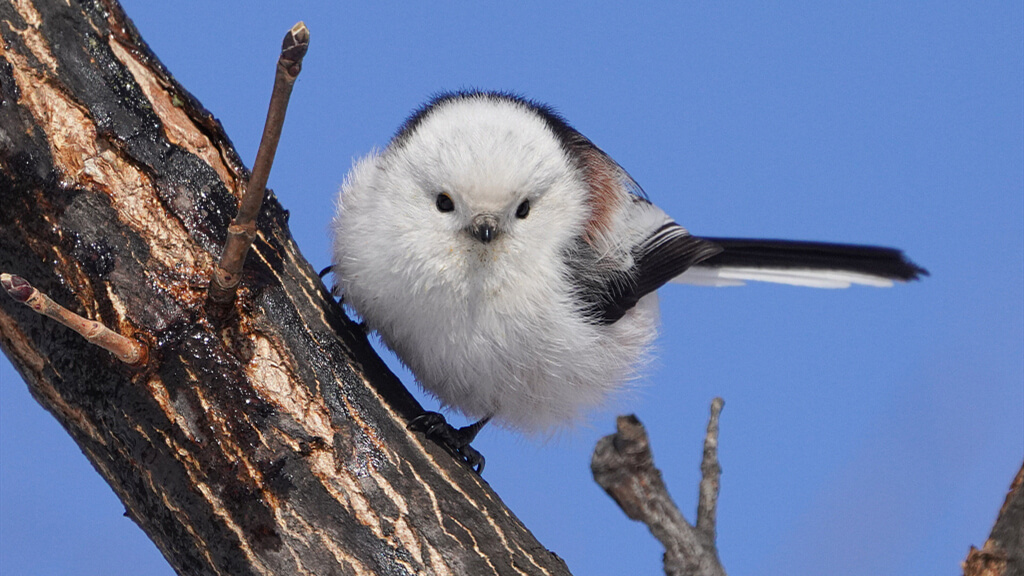Many different species of birds can be observed in our home gardens. We present the most common garden birds to you in a profile.
Wood Pigeon

Name: Columba palumbus
Family: pigeons (Columbidae)
Description: gray with a reddish-gray belly, white wing feathers, and white spots on the neck
Singing: cooing, rhythmic, and muffled
Occurrence: all year round
Habitat: originally open landscapes; today more parks and cemeteries in cities
Food in nature: seeds, grains
Nest: rice nest in conifers, on buildings
Other: The wood pigeon can be easily distinguished from the street pigeon by the white spot on the neck.
Robin

Name: Erithacus rubecula
Family: Flycatchers (Muscicapidae)
Description: brown top with red-orange throat
Singing: long, melodic, and high verse
Occurrence: all year round
Habitat: dense forests, gardens on the edge of the forest, parks with dense shrubbery and trees
Food in nature: insects, larvae, fruits, parts of plants
This is how you can add: Soft food: oat flakes dipped in oil, poppy seeds, fruit, raisins – preferably from the ground
Nest: close to the ground, e.g. B. in caves or dense bushes
Other: The robin singing can be heard early in the morning.
Rook

Name: Corvus frugilegus
Family: Corvidae
Description: black, light-colored bill without feathering at the base
Singing: croaks
Occurrence: all year round
Habitat: agricultural areas, cities
Food in nature: crops, insects, grain seeds, earthworms, snails
Nest: tree tops
Other: The rook is similar in size to the carrion and hooded crow, but can be differentiated by its beak.
Tail tit

Name: Aegithalos caudatus
Family: Tail tits (Aegithalidae)
Description: brown-white with dark neck and back, long tail
Singing: high-pitched twittering and chirping
Occurrence: all year round
Habitat: moist deciduous and mixed forests with dense undergrowth, larger parks, and gardens with dense vegetation
Food in nature: insects, larvae, spiders, aphids, mosquitoes, buds, seeds
This is how you can feed: Offer bran mixed with vegetable fat at the feed house.
Nest: made of moss and feathers in the branches
Other: The tail tit uses its tail for balancing.
Song thrush

Name: Turdus philomelos
Family: Thrushes (Turdidae)
Description: beige-brown top with white, spotted underside
Singing: melodic, mostly triple repetition of a motif
Occurrence: March to August
Habitat: spruce and fir forests, gardens and parks with older trees
Food in nature: snails, insects, larvae, worms, fruits, berries
This is how you can add: soft food, oat flakes in oil, fruits
Nest: in forks of branches, lined with chewed wood and clay
Other: The song thrush can usually be heard in the evening.
Star

Name: Sturnus vulgaris
Family: Starlings (Sturnidae)
Description: black with a metallic sheen in violet, green, and blue (spring); brown plumage with white tips (autumn)
Singing: changing tone sequences, whistling, hissing, clicking; Imitating other birds or sounds
Occurrence: all year round
Habitat: agricultural areas, forest edges, and clearings
Food in nature: snails, earthworms, spiders, flies, ticks, fruits, berries
So you can add: fatty food, fruits, and berries, seeds
Nest: caves on buildings or in stables; Star boxes
Other: The star is bird of the year 2018.
Goldfinch

Name: Carduelis carduelis
Family: Finches (Fringillidae)
Description: brown back, white belly, red face mask, black tail and wings, yellow wing band
Singing: polysyllabic calling, loud chirping
Occurrence: all year round
Habitat: light forests, semi-open landscapes, avenues, parks, gardens, rural areas, and in the city
Food in nature: seeds, rarely insects
This is how you can feed: Offer grain mixtures with fine seeds at the bird feeder.
Nest: in the treetops or in the bushes
Other: Goldfinches used to be kept as pets. The removal of wild animals from nature is of course prohibited today. The keeping of birds of this kind is subject to strict regulations, which must be clarified with the responsible authorities before purchasing them.
Coal Tit

Name: Parus ater
Family: Titmouse (Paridae)
Description: beige-brown-white underside, blue-gray back and wings, black head, white cheeks
Singing: monotonous high pitch sequence
Occurrence: all year round
Habitat: spruce forests, parks, gardens with conifers
Food in nature: seeds of conifers
This is how you can add: fatty food, sunflower seeds, peanut fragments
Nest: tree, rock and earth caves
Other: The coal tit looks very similar to the great tit, but it is smaller and, unlike the great tit, does not have a black stripe on its chest.
Wren

Name: Troglodytes troglodytes
Family: Wrens (Troglodytidae)
Description: small, brown-banded plumage, erect tail
Singing: louder, thunderous
Occurrence: all year round
Habitat: Forests and gardens with thick bushes and hedges; often near streams and rivers
Food in nature: spiders, flies, insects, larvae
This is how you can feed it: Lay out fatty food on the floor
Nest: spherical nests
Other: The wren weighs only 10 grams, but can reach a volume of up to 90 decibels.
Chiffchaff

Name: Phylloscopus collybita
Family: Warblers (Sylviidae)
Description: olive-colored top, light bottom
Singing: monotonous sequence of individual tones that sound like “zilp-zalp”
Occurrence: March to October
Habitat: Forests, bushes, parks, gardens
Food in nature: insects, spiders, berries, fruits
Nest: spherical nest close to the ground
Other: The ZilpZalp looks very similar to the Fitis. However, it is darker overall.
